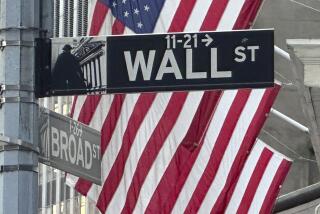Leading Indicators Decline More Than Expected
- Share via
A closely watched gauge of future business activity fell more than expected in May, indicating slower economic growth may lie ahead this year, a private research group said Monday.
The New York-based Conference Board reported that its composite index of leading economic indicators fell 0.5% last month to 114.1. The decline was more than the 0.2% drop analysts had expected.
The decrease follows a revised unchanged level in April and a 0.6% decline in March.
Ken Goldstein, the board’s labor economist, said the indicators suggested “slower growth setting in during the third quarter.”
But he added that this was “not just a domestic phenomenon.” He noted that six of the eight countries for which the Conference Board monitors a leading economic index had either showed declines or slower growth.
Mark Vitner, senior economist at Wachovia Corp. in Charlotte, N.C., said he was not worried about the decline.
“This is a sign of a slower economy but not anything more serious than that,” he said.
Vitner noted that a large part of the weakening in the leading indicators over the last few months had been the decline in financial components of the index -- which include an interest rate comparison and real money supply -- as a result of rising interest rates.
The Conference Board reported Monday that only one of the 10 components of the leading index -- stock prices -- increased in May.
The other components that dragged down the index included building permits, vendors’ performances, the index of consumer expectations, manufacturers’ new orders for non-defense capital goods, consumer goods and materials and average weekly initial claims for unemployment insurance.
Vitner added that the Federal Reserve’s moves to push short-term interest rates higher over the last year to keep inflation in check was working, and “we are nearing the point that they will leave it unchanged and let the economy regain momentum.” He expects the Fed to raise rates when policymakers meet in June and August.
The index of coincident indicators, which measures the current economy, rose 0.2% in May to 119.7. The gain followed a 0.2% increase in April and no change in March from the previous month. All four components that make up the coincident index increased in May, led by industrial production. The others were personal income less transfer payments, employees on nonagricultural payrolls and manufacturing and trade sales.
The index of lagging indicators, which looks at the last six months, increased 0.3% to 99.8. That followed a 0.1% rise in April and a 0.2% decline in March. Four of the seven components strengthened, led by the average duration of unemployment. The negative contributor was a change in the consumer price index for services. The change in labor cost per unit of output held steady, as did the ratio of consumer installment credit to personal income.
More to Read
Inside the business of entertainment
The Wide Shot brings you news, analysis and insights on everything from streaming wars to production — and what it all means for the future.
You may occasionally receive promotional content from the Los Angeles Times.










